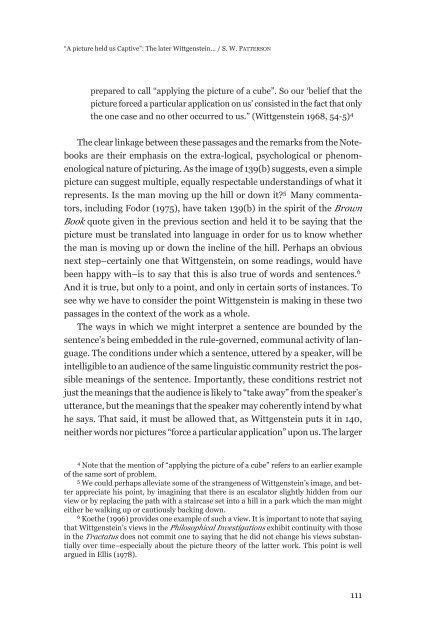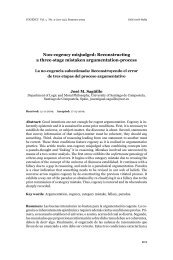Cogency v2 n2
Cogency v2 n2
Cogency v2 n2
Create successful ePaper yourself
Turn your PDF publications into a flip-book with our unique Google optimized e-Paper software.
“A picture held us Captive”: The later Wittgenstein... / S. W. PATTERSON<br />
prepared to call “applying the picture of a cube”. So our ‘belief that the<br />
picture forced a particular application on us’ consisted in the fact that only<br />
the one case and no other occurred to us.” (Wittgenstein 1968, 54-5) 4<br />
The clear linkage between these passages and the remarks from the Notebooks<br />
are their emphasis on the extra-logical, psychological or phenomenological<br />
nature of picturing. As the image of 139(b) suggests, even a simple<br />
picture can suggest multiple, equally respectable understandings of what it<br />
represents. Is the man moving up the hill or down it? 5 Many commentators,<br />
including Fodor (1975), have taken 139(b) in the spirit of the Brown<br />
Book quote given in the previous section and held it to be saying that the<br />
picture must be translated into language in order for us to know whether<br />
the man is moving up or down the incline of the hill. Perhaps an obvious<br />
next step–certainly one that Wittgenstein, on some readings, would have<br />
been happy with–is to say that this is also true of words and sentences. 6<br />
And it is true, but only to a point, and only in certain sorts of instances. To<br />
see why we have to consider the point Wittgenstein is making in these two<br />
passages in the context of the work as a whole.<br />
The ways in which we might interpret a sentence are bounded by the<br />
sentence’s being embedded in the rule-governed, communal activity of language.<br />
The conditions under which a sentence, uttered by a speaker, will be<br />
intelligible to an audience of the same linguistic community restrict the possible<br />
meanings of the sentence. Importantly, these conditions restrict not<br />
just the meanings that the audience is likely to “take away” from the speaker’s<br />
utterance, but the meanings that the speaker may coherently intend by what<br />
he says. That said, it must be allowed that, as Wittgenstein puts it in 140,<br />
neither words nor pictures “force a particular application” upon us. The larger<br />
4<br />
Note that the mention of “applying the picture of a cube” refers to an earlier example<br />
of the same sort of problem.<br />
5<br />
We could perhaps alleviate some of the strangeness of Wittgenstein’s image, and better<br />
appreciate his point, by imagining that there is an escalator slightly hidden from our<br />
view or by replacing the path with a staircase set into a hill in a park which the man might<br />
either be walking up or cautiously backing down.<br />
6<br />
Koethe (1996) provides one example of such a view. It is important to note that saying<br />
that Wittgenstein’s views in the Philosophical Investigations exhibit continuity with those<br />
in the Tractatus does not commit one to saying that he did not change his views substantially<br />
over time–especially about the picture theory of the latter work. This point is well<br />
argued in Ellis (1978).<br />
111








